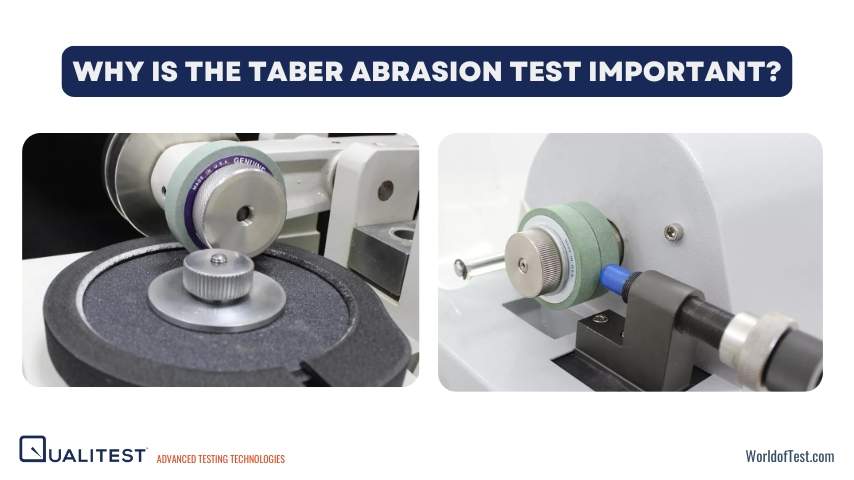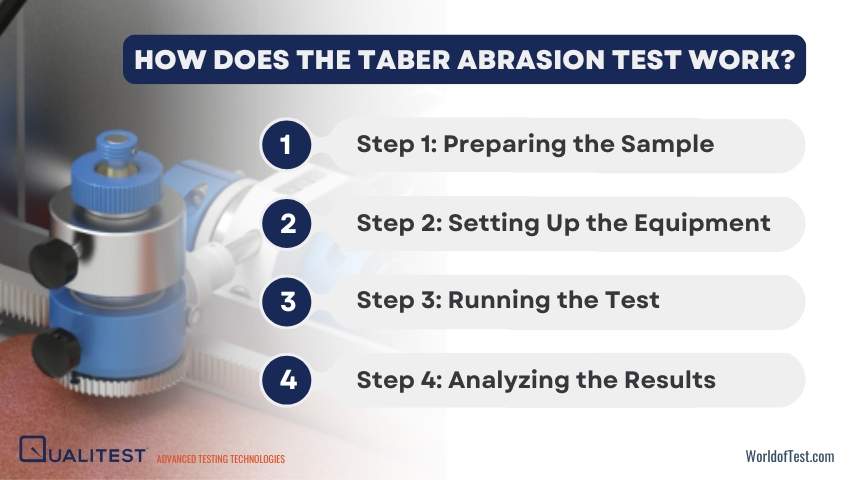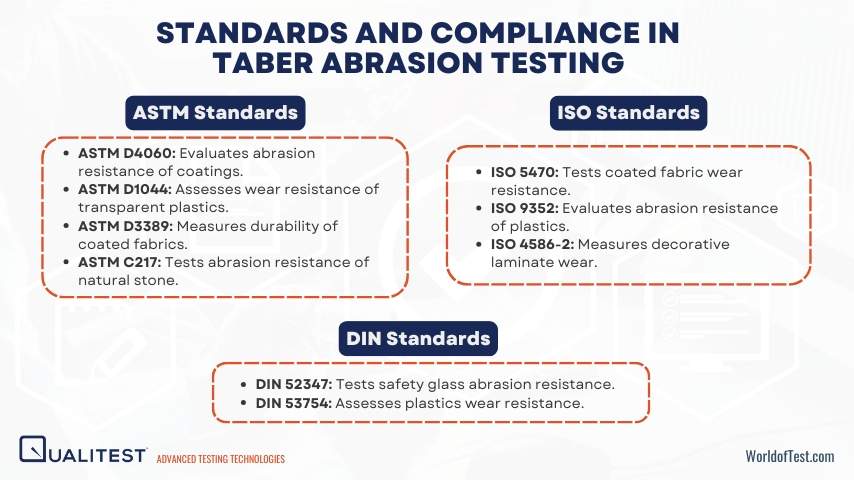When it comes to assessing material durability, the Taber Abrasion Test is a trusted method used across industries. By simulating repeated friction and wear, this test helps you understand how your products will hold up over time, ensuring they meet performance expectations and comply with standards like ASTM D4060.
If you're involved in product development or quality control, the Taber Abrasion Test is an important tool in your toolkit. With the right Taber abrasion test equipment, you can gain valuable insights into material performance, optimize your designs, and deliver products that stand the test of time.
Let’s break down how this test works and how it can benefit your projects.
What is the Taber Abrasion Test?

The Taber Abrasion Test (also referred to as the Taber Abraser Test or Taber Abrader Test) is a standardized method used to measure the abrasion resistance of materials. In simple terms, it helps you determine how well a material can withstand wear and tear caused by friction, rubbing, or scraping.
This test is widely used across industries to ensure that products like coatings, plastics, textiles, and flooring can endure real-world conditions without degrading too quickly. For your information, the term 'Taber' refers to Taber Industries, the original designer and patent holder of the Taber Abrasion Tester.
At its core, the Taber abrasion test method involves rotating a material sample against abrasive wheels under a controlled load. The amount of material lost -measured by weight or thickness- or the change in appearance (e.g., scratches, haze, or gloss reduction) is then recorded.
This process is carried out using specialized equipment, such as a Taber abrasion machine or rotary abrasion tester, which ensures consistent and repeatable results.
Why is the Taber Abrasion Test Important?

Imagine you’re designing a product that will face constant friction, like a car seat fabric, a smartphone casing, or a high-traffic floor coating. How do you ensure it won’t wear out prematurely?
This is where the Taber Abrasion Test becomes invaluable. By simulating years of wear in a controlled environment, this test helps you predict how your material will perform over time.
The Taber abrasion test procedure is designed to mimic real-world conditions, making it a trusted method for quality assurance. Whether you’re following the Taber abrasion test ASTM D4060 standard or other Taber abrasion test standards, this test helps you:
- Enhance product durability
- Maintain compliance with industry regulations
- Select the best materials for specific applications
- Reduce product failures and costly returns
How Does the Taber Abrasion Test Work?

The abrasion test procedure follows a structured process to deliver precise and consistent data:
Step 1: Preparing the Sample
A 100mm square or round specimen is cut and mounted on the Taber type abrasion tester. Ensuring the sample is clean and free of defects prevents inaccurate test results.
Step 2: Setting Up the Equipment
The Taber Abraser is equipped with abrasive wheels such as CS-10, H-18, or Calibrade, depending on the material type. A 250g, 500g, or 1000g load is applied to create uniform testing conditions. You can adjust the test parameters based on your specific material needs.
Step 3: Running the Test
Once the test begins, the sample rotates at 60 or 72 rpm while the wheels create abrasion patterns. A vacuum system continuously removes debris to ensure accurate results.
Step 4: Analyzing the Results
After the test, you assess results using one or more of the following methods:
- Weight Loss: The sample is weighed before and after testing to determine material loss.
- Thickness Reduction: Measurements in micrometers help evaluate structural changes.
- Appearance Changes: Scratches, haze, or gloss reduction indicate surface degradation.
Applications of the Taber Abrasion Test

Many industries rely on abrasion testing to improve material performance and longevity. Here are some key applications:
1. Coatings and Paints
If you’re working with coatings or paints, the Taber Abrasion Test is essential for evaluating their resistance to scratches, scuffs, and wear. For example, floor coatings, automotive paints, and industrial finishes are often subjected to this test to ensure they can withstand heavy use. By following standards like ASTM D4060, you can guarantee that your coatings meet industry expectations for durability.
2. Plastics and Polymers
Plastics are used in everything from consumer electronics to medical devices, and their ability to resist abrasion is critical. The Taber abrasion test method helps you assess how well plastic materials can endure friction and wear, ensuring they remain functional and visually appealing over time. This is especially important for products like smartphone casings, appliance components, and packaging materials.
3. Textiles and Fabrics
In the textile industry, the Taber Abraser Test is used to evaluate the wear resistance of fabrics, such as upholstery, clothing, and industrial textiles. For instance, car seat fabrics or outdoor gear must withstand constant friction without tearing or losing their appearance. By using a Taber abrasion machine, you can simulate years of use and ensure your textiles meet quality standards.
4. Automotive Components
The automotive industry relies heavily on the Taber Abrasion Test to ensure the durability of components like dashboards, seat covers, and interior trims. These parts are exposed to constant wear from passengers, sunlight, and cleaning, making abrasion resistance a top priority. The Taber abrasion test ASTM D4060 is often used to validate the performance of these materials.
5. Flooring and Construction Materials
Flooring materials, such as laminate, vinyl, and hardwood, are subjected to heavy foot traffic and cleaning, making abrasion resistance a key factor. The Taber Abrasion Test helps manufacturers evaluate how well these materials can withstand daily wear, ensuring they remain functional and attractive for years.
6. Packaging and Consumer Goods
Even packaging materials, such as labels and protective films, need to resist abrasion during handling and transportation. The Taber abrasion testing method ensures that these materials can endure friction without losing their integrity or appearance.
Standards and Compliance in Taber Abrasion Testing

When it comes to material testing, consistency and accuracy are non-negotiable. That’s why the Taber Abrasion Test is governed by a variety of international and industry-specific standards. Let’s explore the key standards and their applications.
ASTM Standards
- ASTM D4060: Evaluates abrasion resistance of coatings.
- ASTM D1044: Assesses wear resistance of transparent plastics.
- ASTM D3389: Measures durability of coated fabrics.
- ASTM C217: Tests abrasion resistance of natural stone.
ISO Standards
- ISO 5470: Tests coated fabric wear resistance.
- ISO 9352: Evaluates abrasion resistance of plastics.
- ISO 4586-2: Measures decorative laminate wear.
DIN Standards
- DIN 52347: Tests safety glass abrasion resistance.
- DIN 53754: Assesses plastics wear resistance.
How to Interpret Taber Abrasion Test Results
Once you’ve conducted the Taber Abrasion Test, the next step is understanding what the results mean for your material’s performance. Let’s break down how to analyze the results and what they can tell you.
1. Cycles to a Specific End-Point
If you need to determine how long a material can endure abrasion before failure, cycles to a specific end-point is a useful method. This involves running the test until a predefined condition is met, such as:
- A noticeable loss in breaking strength (for textiles)
- Coating failure (such as flaking, peeling, or substrate exposure)
- Gloss reduction or color fading
- Surface wear patterns becoming visible
The test stops when the material reaches the defined limit, allowing you to compare how different materials hold up under identical conditions.
2. Weight (Mass) Loss Method
If you need a precise measurement of how much material has been removed, weight loss is a direct and widely used method. The sample is weighed before and after the test, and the difference is recorded in milligrams.

Where:
- L = Weight loss (mg)
- A = Initial weight (mg)
- B = Final weight (mg)
To ensure accurate measurements, cleaning off loose debris before weighing is essential.
3. Taber Wear Index
To compare materials tested under the same conditions, the Taber Wear Index is calculated using the following formula:

Where:
- I = Wear index (rate of material loss)
- A = Initial weight (mg)
- B = Final weight (mg)
- C = Number of test cycles
A lower wear index indicates better abrasion resistance. This metric allows you to evaluate different materials based on their resistance to surface wear over a set number of test cycles.
4.Volume Loss Correction for Material Density
When comparing materials with different densities, normalizing the results using volume loss correction ensures an accurate comparison. To do this, divide the Taber Wear Index by the material’s specific gravity.
Since denser materials tend to show higher mass loss, applying this correction provides a more realistic picture of true wear resistance.
5. Wear Cycles Per Mil (0.001 inch)
For coatings, wear cycles per mil is a valuable measure that expresses how many abrasion cycles are required to wear through a known coating thickness.

Where:
- W = Wear cycles per mil
- D = Number of cycles to reach substrate
- T = Coating thickness (mils)
This method helps determine whether a coating is suitable for applications where surface durability is critical.
6. Depth of Wear
Measuring depth of wear provides another way to assess material resistance. A thickness gauge or an optical micrometer is used to measure the sample before and after the test at multiple points. The average difference represents the depth of material removed.
This method is particularly useful for coatings and materials where thickness consistency is critical.
7. Residual Breaking Force for Textiles
For fabrics, residual breaking force measures how much strength remains after the abrasion test. Using the procedures from ASTM D5034 and D5035, a tensile test determines the breaking force before and after abrasion. The percentage loss in breaking strength is then calculated:

Where:
- AR% = Abrasion resistance percentage
- X = Breaking force before abrasion
- Y = Breaking force after abrasion
Lower percentage loss indicates better abrasion resistance.
Final Thoughts
Every industry relies on durable materials, and abrasion resistance testing helps you ensure your products can withstand wear and tear. The Taber Abrasion Test provides an effective way to measure how coatings, plastics, and textiles perform under repeated friction. By following a standardized test method, you gain valuable insights into material performance, helping you improve product design and prevent premature failures.
For reliable testing, please visit our website. We offer an extensive range of Taber type Abrasion Testers and accessories ensuring you get accurate, repeatable results for material evaluation.